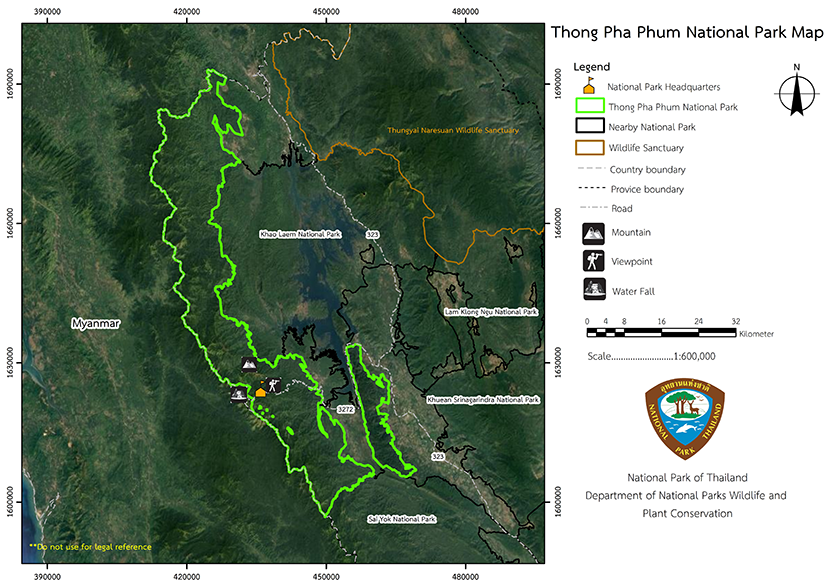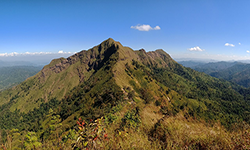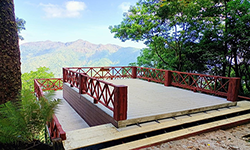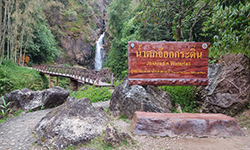Thongphaphum National Park
Contact Location : Thongphaphum National Park, PO Box 18, Thong Pha Phum District in Kanchanaburi Province 71180.
Telephone Number : (+66) 3 451 0979, Fax: (+66) 3 451 0979
Email : thongphaphum_np@hotmail.com
Facebook : Thongphaphum National Park
Information
The Secretariat of the Cabinet submitted a plan to conserve and develop the Western Conservation Forest, which was forwarded to the Ministry of Agriculture and Cooperatives and the Ministry of Science, Technology, and Development for consideration. On May 1, 1991, the Council for International Economic Policy proposed that the Myanmar's border area to be protected as a single large forest to preserve the ecosystem's stability and the country's abundant plant and animal resources. Following that, on August 20, 1991, the Ministry held a consultation meeting to approve the Royal Forest Department's resolution to implement a plan to conserve and develop the Western Conservation Forest as a national park.
Thong Pha Phum National Park is located within Huai Khayeng and Khao Chang Phueak National Reserved Forest in Thong Pha Phum District and Sangkhlaburi District in Kanchanaburi Province. This is a forest area was declared a national park with an area of approximately 700,000 rai or 1,120 square kilometers. The border territories are as follows: Thung Yai Naresuan Wildlife Sanctuary to the north. Sai Yok National Park to the south. Khao Laem National Park in the east, and the Thai-Myanmar border to the west. The National Parks Division under the Royal Forest Departmentbrought the matter into consideration by the National Park Board on May 18th, 2000, which approved the establishment of a National Park.
Note : After paying the entrance fee to the National Park, please carry the receipt for inspection.

772,214.27 rai (1,120 square kilometers)
|
|
|
||
|
|
|||
Nature trails ⇔ Trekking ⇔ Visit Waterfall ⇔ Camping
Welfare shop : open daily from 8:00 - 18:00 hrs. from Monday to Friday and on Saturday to Sunday open from 7.00 - 19.00 hrs.
Mobile phone signal :
- Noen Kut Doi Noen - Changphueak: AIS, DTAC, TRUE
- Chokkradin Waterfall: AIS
|
|
The major topography is that of folded complex mountains along the north-south oriented, part of Tanaosi Mountain range. There are only a few plains. The altitude is between 100 and 1,249 meters above sea level. Khao Chang Phueak is the highest summit located in the west. Major summits are Khao Chang Phueak, Khao Nisa, Khao Phu Thong, Khao Dang, Khao Pak Pratu, Khao Lo Lo, Khao Pra Nong Tho Khi, and Khao Cha Long. It is the catchment are for many waterways such as Malai Creek, Kop Creek, San Creek, Ong Phra Creek, Pi Khi Creek, Pak Khok Creek, and Chet Mit Creek by flowing into the eastern plains into Khao Laem Dam. Other creeks flow into Khwae Noi River.
|
|
This area is influenced by tropical monsoon. Summer is from February to April, rainy season runs from May to July, and winter lasts from November to January.
|
|
|
|
Thong Pha Phum National Park is part of the western forest with its original natural stage. The forest types can be divided into 4 categories: Due to its proximity to Myanmar, Thong Pha Phum National Park is home to a variety of wildlife, which migrate between the countries on a regular basis. The forest is sparsely populated and the wildlife is fairly undisturbed. Regular appearances include Asian Elephants, Serows, Deer, Barking Deer, Mouse Deer, Wild Boars, Bears, Monkeys, Langurs, Sunda Flying Lemurs, Gibbons, Common Palm Civet, Civet, Fishing Cats, Clouded Leopards, Tigers, Malayan Sun Bear, Asian black bear, Pteromyini, Premna herbacea Roxb , Mus musculus , Mongoose, Bat, Burmese Hare , Wild Cat, Dhole, and Porcupine. There is also lots of birdlife including Hornbill, Swallow, Falcon, Grey Heron , Eagle, Owl, Bulbul, Black-Crowned Night Heron, Asian Barred Owlet, Barn Owl, Greater Coucals, Mynas, Oriental Magpie Robin, Oriole, Scaly-Breasted Partridge, White-breasted Waterhen, Hill Myna, Drongo, Woodpecker, Western Koel, Eastern Jungle Crow and Red Junglefowl , Red Junglefowl . Reptiles include Tree Lizard, Gecko, Flying Lizard, Skink, Butterfly Lizard, Centipede, Scorpiones, Millipede, Leech,, Leeches, Asiatic Softshell Turtle, Frogs, Puddle Frog, Toads, Chubby Frog, Tor tambroides, Minnow, Red-tailed Snakehead , Striped Snakehead, Eel, Armed Spiny eel, Silver Barb , Climbing Perch, Mystus micracathus, and Giant Snake-Head Fish. |
How to get there by car :
After traveling to Kanchanaburi city, which is a distance of 123 kilometers from Bangkok, travelers should then take Highway No.323, Kanchanaburi - Thong Pha Phum route to Thong Pha Phum District Market, which is a distance of 141 kilometers. From Thong Pha Phum District, take route number 3272 Thong Pha Phum - Ban rai - Pilok. At Ban rai Intersection, turn left, up the hill to Thong Pha Phum National Park Headquarters, which is located between the milestone No. 21 - 22. All roads on this journey are paved.
How to get there by Bus
Visitors should take a bus from the Southern (Sai Tai Mai) Bus Terminal to Kanchanaburi, and then transfer on to Kanchanaburi - Thong Pha Phum bus which terminates at Thong Pha Phum District Market. Then take Thong Pha Phum - Ban I Tong bus to Thong Pha Phum National Park Headquarters.
- National Park Ranger Station Tho Pho No. 1 (Nam Dib)
- National Park Ranger Station Tho Pho No. 2 (Mai Yak)
- National Park Ranger Station Tho Pho No. 3 (Pong Phu Ron)
- National Park Ranger Station Tho Pho No. 4 (Pha On)
- National Park Ranger Station Tho Pho No. 5 (Ban rai)
- National Park Ranger Station Tho Pho No. 6 (Pong Chang)
- National Park Ranger Station Tho Pho No. 7 (Viacardi)
- National Park Ranger Station Tho Pho No. 8 (Khao Yen)
- National Park Ranger Station Tho Pho No. 9 (Ban Prarai Nok)
Accommodation - Thong Pha Phum 101 (Tarzan1)
- Thong Pha Phum 102 (Taezan 2)



